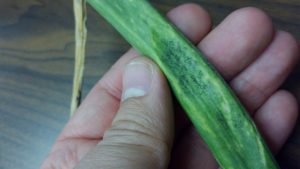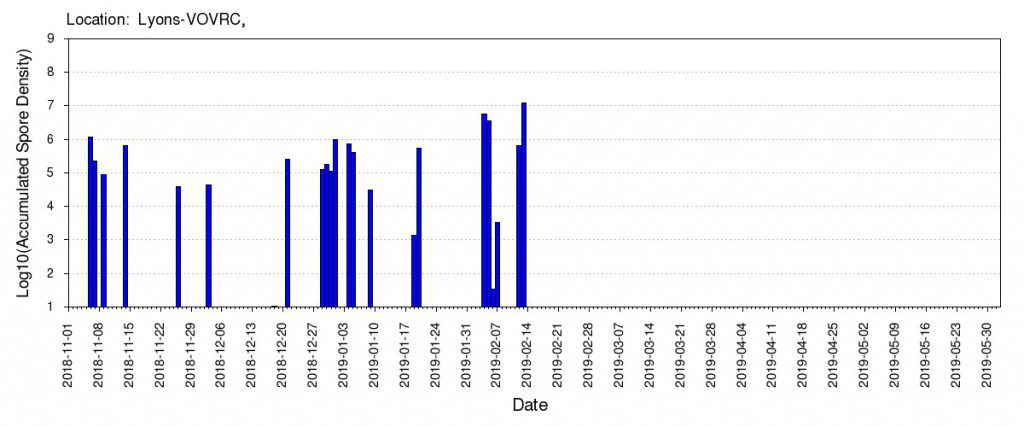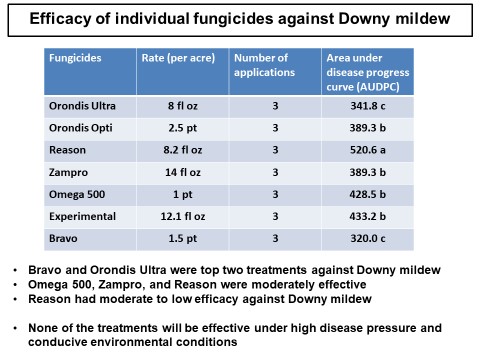
It’s that time of year again when we start to worry about Downy Mildew (Peronospora destructor) on our onions. As of this time, none has been reported to me in the Vidalia area. Growers need to be vigilant in protecting their onions against this disease. We have used a “Forecast Model” for the past several years to help warn growers when conditions are favorable for disease development. This model is paid for by the growers and tracks weather conditions at several locations in the Vidalia Onion growing region.
Last week, the week of February 11th-15th, the forecast model gave us a “warning” that conditions were favorable for Downy Mildew development. This does not necessarily mean that Downy Mildew is present, but if it was, conditions are favorable for it to reproduce and spread rapidly.
So what does this mean to you as a grower? It means that we need to take precautions for this disease. If you haven’t already, you may want to make sure you have products to spray that will protect against this disease, and make sure you are using them in your spray program.

So what do we need to be using to protect our onions from Downy Mildew? Below is a summary of last year’s research trials, conducted by Dr. Bhabesh Dutta. He shared this information at the last grower production meeting:

Let’s explain your options, based on the most recent (2018) UGA research data. I want to provide some options and how I rank them in terms of potential. I use these as a TIER system of better products to somewhat beneficial. Below are the products and a brief justification. Hopefully this information can be utilized to help you make a decision for your spray program. Remember, a good downy spray program includes rotating chemistries and not relying solely on one product. A good spray program can include products from all of these “tiers”.
TIER 1: (Most reliable,based on UGA data)
Orondis Ultra: Active ingredients are Oxathiapiprolin + Mandipropamid (Revus). In last year’s trial it was a top performer. This product would be a good fit if you have an active outbreak, or for preventative use. It has curative activity.
Bravo: Active ingredient chlorothalonil. This product also did really well in last year’s trial. Bravo does not have curative activity, but it has good protectant qualities.
***Note about Bravo: I don’t want there to be any confusion about our Bravo recommendation. Bravo has been used for many years on onions and other crops and has a lot of value in a fungicide spray program. While Bravo performed very well in this test, keep in mind that it was sprayed each week on those onions. I like to think of Bravo as a “coat of paint” or “protective barrier” that keeps disease from developing on the leaves. However, this protective barrier is only as good as your spray coverage and only lasts so long. It gets washed off and broken down by rain, irrigation, and sunlight. In this trial a constant “coating” of Bravo was maintained on the leaves during the test, and it worked well. However, most growers may not be able to spray their onions every week and may only apply Bravo every 14 or 21 days. Bravo works as a protectant/preventative for disease. Do I think Bravo is a good option use in downy prevention? Yes. And it can be applied with some of the other products, such as a Phosphoric acid, for an economical preventative spray. Am i saying that we should rely on Bravo solely for downy prevention? No. If we had an active outbreak of downy, I would recommend using the Orondis or Zampro or Omega 500 as a go to. However, it could be tank mixed with some of these products.
TIER 2: (Moderate/Good)
Orondis Opti: Active Ingredients Oxathiapiprolin + chlorothalonil (Bravo). Showed good results, did not do as well as Orondis Ultra or Bravo alone. Contains curative and protectant active ingredients
Zampro: Active ingredients Ametoctradin + Dimethomorph. Showed good efficacy last year.
Omega 500: Active ingredient Fluazinam. Showed good efficacy last year, also good for other diseases as well.
**Reason: In the past, Reason was a top tier product. Last year’s data does not support this recommendation. We are changing our ranking of the product based on the most recent UGA data.
TIER 3 (Some benefit):
Phosphoric Acid: Phosphoric acids such as Phostrol, ProPhyt, KPhite, and others have shown to be slightly effective at preventing downy in some studies. They are a cheaper option, and have some benefit to the overall fungicide program.
Maneb: Dithane, Pencozeb, etc… the maneb products are listed as somewhat effective. I wouldn’t count on much help if we get to the point of seeing downy, but they may be offering some prevention.